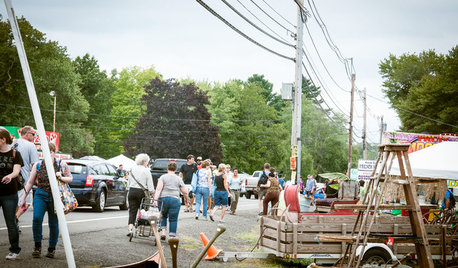What happened to my lawn?
fojaker
11 years ago
Related Stories

EVENTSHappening Now: The Brimfield Antique Show
Take a peek at the largest outdoor antiques show in the United States
Full Story
MOST POPULARMeet a Lawn Alternative That Works Wonders
Carex can replace turfgrass in any spot, is low maintenance and adjusts easily. Add its good looks and you’ve got a ground cover winner
Full Story
GROUND COVERSGive Your Lawn a Taste of the Wild
Consider the joys of an irregularly trimmed meadow lawn: It’s ecofriendly, visually interesting and still good for romping
Full Story
BEFORE AND AFTERSSee 6 Yards Transformed by Losing Their Lawns
Wondering whether a turf lawn is the best use of your outdoor space? These homeowners did, and they found creative alternatives
Full Story
EARTH DAYThe Case for Losing the Traditional Lawn
Work less, help the environment and foster connections by just saying no to typical turf
Full Story
LANDSCAPE DESIGNCalifornia Says Goodbye to the Sprawling Ornamental Lawn
New state rules will effectively limit turfgrass to 25 percent of the landscape in most new and renovated yards
Full Story
GREAT HOME PROJECTSHow to Replace Your Lawn With a Garden
New project for a new year: Lose the turfgrass for energy savings, wildlife friendliness and lower maintenance
Full Story
FRONT YARD IDEASBefore and After: Front Lawn to Prairie Garden
How they did it: Homeowners create a plan, stick to it and keep the neighbors (and wildlife) in mind
Full Story
LANDSCAPE DESIGNGet Along With Less Lawn — Ideas to Save Water and Effort
Ditch the mower and lower your water bill while creating a feast for the eyes with diverse plantings and gathering places
Full Story
GARDENING GUIDESHow to Plant a New Lawn From Sod
Take the quick-start route to turf with sod; these installation guidelines will help ensure a healthy and long-lasting lawn
Full StoryMore Discussions








grass1950
grass1950
Related Professionals
Arlington Landscape Architects & Landscape Designers · Cottonwood Landscape Architects & Landscape Designers · Vernon Hills Landscape Architects & Landscape Designers · Andover Landscape Contractors · Cockeysville Landscape Contractors · Davidson Landscape Contractors · Doctor Phillips Landscape Contractors · Medford Landscape Contractors · New Brighton Landscape Contractors · Plantation Landscape Contractors · Roseville Landscape Contractors · Santa Ana Landscape Contractors · South Portland Landscape Contractors · Tinton Falls Landscape Contractors · San Dimas Swimming Pool BuildersfojakerOriginal Author
grass1950
kidhorn
fojakerOriginal Author
grass1950
fojakerOriginal Author
dchall_san_antonio
fojakerOriginal Author
fojakerOriginal Author
grass1950
fojakerOriginal Author